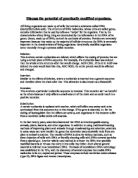In 1976, as part of treatment from a rare form of leukemia, John Moore underwent a splenectomy, which resulted in successful treatment of the disease. Unknown to Moore, his surgeon preserved a sample of the cells, this was potentially of great value to the pharmaceutical
industry. Moore’s legal advisers discovered that in 1984, UCLA had obtained a patent on the cell line through Moore’s surgeon. Also, UCLA had entered into very lucrative contracts with a number of biotechnology firms with the intention of commercialising the cell line, at an estimated $3 million (US) profit to the surgeon alone.
Moore took action against the university, declaring ownership of the cells and claiming that his surgeon had failed to obtain full consent for their commercialisation. Despite winning at first, Moore eventually lost the case and the patent on his cells was deemed legally binding [Moore v Regents of the University of California]. The reasoning behind this judgment was that once human tissue is removed from the body, it can no longer be owned by the source.
The views expressed by the US Supreme Court in the Moore case, and by those who generally support human patents essentially believe that “…the body is just another possession and can therefore be owned not just by the ‘source person,’ but by anyone else who wishes to obtain a valid patent. Thus, if removed material comes into the possession and ownership of others, they may deal with it as they see fit.” This is the same both statewide, nationally and internationally as the patent laws are internationally shared, this is important as genes are international also.
Myriad Genetics, an American company based in Salt Lake City, owns the patents on two genes, BRCA1 and BRCA2 that are believed to increase the risk of breast cancer developing. The patents mean that when Myriad begins operating commercially in Australia, women with breast cancer, or a family history of the disease, could be forced to pay thousands of dollars for genetic testing that they can now receive free in public hospitals. In the United States, Myriad charges $US2600 ($A5120) to test for mutations on the genes. “The head of medical genetics at the University of Newcastle, Rodney Scott, said that the increasing commercialisation of genetic information could mean that only the rich would be able to afford tests of this kind.”
Companies will sometimes invest money in non-profit organizations for research, the funding company can then patent the gene; this is an advantage for the company that funds the research as they receive credit and returns on their investment. Although, often public funding is used, so it is not necessary for other private funding. It is a disadvantage for society with these companies funding these organisations as it prevents these genes from being scientifically advanced because it limits who can research the gene without paying patents and will be discussed further. Also, a patented gene is usually commercialised and money made from it, with all these genes being commercialised it increases the chance of the treatment or testing on these genes being very expensive.
When an organisation funds the research on the genes, they need to know that the money they invest in that research is not dead money. These companies then apply for the patent, and once the gene is patented they will start to receive recognition and get returns on the investment when royalties for the use of the genes are paid.
“Opponents to human patents can usually be seen as believing that the mind and body are connected, and together form the person.” The belief of what is a person extends not only to body parts but individual cells and the human genome itself, since it is the main element from which a human is formed.
Gene patents currently last 20 years, this is a disadvantage of current gene patent. Arising from this are some serious social problems. These problems being that a patent lasting 20 years prevents any other research being conducting on that particular gene without payment to the patent owner. This is not usually possible as the party conducting the research on the gene is a non-profit organisation and cannot afford to pay patent owners to conduct the research. By these organisations not being able to conduct research without paying the patent owners, it slows or even halts the research process and further scientific advances on the gene cannot be made. Patents provide a legal domination on the discovery and innovation of genetic information and therefore, the law should prevent anyone from patenting a human discovery.
If this trend continues, there are problems with loss of control over a humans cells or genes, and also whether or not it constitutes a human rights abuse. Ultimately, the cells and DNA of a body constructs what a person is, the description of a person. If the current patent laws were to be changed so that human materials or human genetic material cannot be patented, like a general product from nature, it would decrease the funding from private investors, but funding would still be available from the public, which is still a large portion of funding.
P. Commandeur (1994) “Symposium: Patents, Genes and Butterflies” Biotechnology and Development Monitor No. 21 pp 3-4
http://www.law.ecel.uwa.edu.au/elawjournal/Volume%201/Articles%20Vol_1/biopiracy.pdf
J.D. Isaacs (1998) “Gene Patenting: The current state of DNA patenting and the stance of those shaping the field.” p 1-2 (http://www.cs.dartmouth.edu/~jisaaces/patent.html)
O’Reilley v Morse 15 How 62 112-121 (1854)
Hartranft v Wiegmann 121 U.S. 609, 615 (1887)
Diamond v Chakrabarty 447 U.S. 303 (1980)
Such a cell line is one that, under laboratory conditions, will grow and multiply indefinitely.
Moore v Regents of the University of California 793 P.2d 479 Cal. (1990)
Op cit Williams Jones p 40
Op cit Moore v Regents of the University of California
Op cit Williams-Jones pp 11-13
http://www.nswccl.org.au/issues/breast_cancer.php



!["Through new technologies, all plants, animals, micro-organisms and human beings, down to their individual genes",[1] are potential resources to be utilised or exploited.](https://mbt-essays-prod-public.s3.eu-west-1.amazonaws.com/38865/listing/38865_1.jpg)



